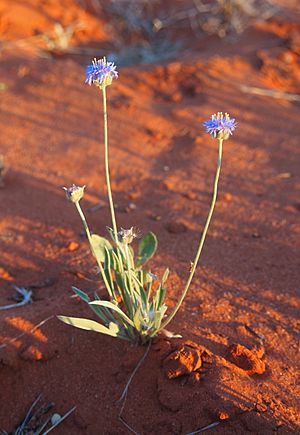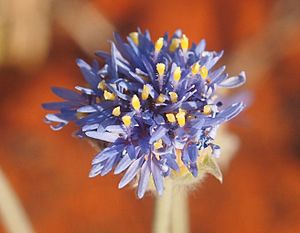Blue pincushion facts for kids
Quick facts for kids Blue pincushion |
|
|---|---|
 |
|
| Scientific classification | |
| Genus: |
Brunonia
|
| Species: |
australis
|
The blue pincushion or native cornflower (scientific name: Brunonia australis) is a pretty plant found all over Australia. It can live for many years (a perennial) or just one year (an annual). It's a type of herb, meaning it has soft stems, not woody ones like trees. You can find it growing in woodlands, open forests, and sandy areas.
This plant used to be in its own special plant family called Brunoniaceae. Now, scientists have moved it into the Goodeniaceae family. It has some unique features, like its flowers that are round and even all the way around (radially symmetric).
Its leaves are about 10 centimeters (4 inches) long. They grow in a circle close to the ground, like a rosette. The plant usually flowers in spring. It grows several stems, up to 50 centimeters (20 inches) tall. Each stem has a dense, round cluster of many small, bright blue flowers.
Naming the Blue Pincushion
Scientists first collected samples of Brunonia plants a long time ago. This happened during a trip around Australia in 1801–1802. The trip was led by Matthew Flinders on a ship called HMS Investigator. A famous botanist named Robert Brown collected these plants.
In 1810, members of the Linnean Society of London wanted to name a plant after Robert Brown. They chose this plant because it was very hard to classify. It seemed related to many different plant groups, making it a puzzle for scientists.
They decided to name it Brunonia. Another plant genus was already named Brownea after a different person, Patrick Browne. So, Brunonia was a good compromise. It sounded similar to Brown's name but avoided confusion.
In February 1810, a scientist named James Edward Smith officially described Brunonia to the Linnean Society. He named two species: Brunonia australis and Brunonia sericea. Later that year, Robert Brown used these names in his own book about Australian plants.
However, Smith's description was not printed until 1811. This means Robert Brown's book was published first. So, even though Smith described it, Brown officially gets the credit for naming the genus. It was a bit unusual because Brown ended up naming a plant after himself without meaning to!
Over time, scientists realized that B. sericea was actually the same as B. australis. So, today, B. australis is the only recognized species in the Brunonia group.
Growing Blue Pincushion Plants
It's fairly easy to grow blue pincushion plants. You can start them from seeds. You can also divide larger, existing plants into smaller ones.
However, these plants can sometimes be tricky to get started. They might also die after a few years. For the best results, plant them in soil that drains water well. They like to grow in places that get full sun or partial shade.
See also
 In Spanish: Brunonia australis para niños
In Spanish: Brunonia australis para niños


